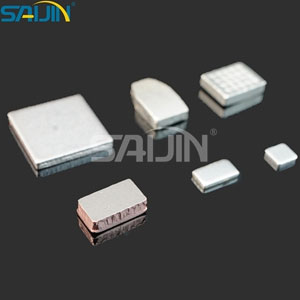The difference between spot welding and projection welding
In the metal connection process, resistance welding technology is widely used in the fields of automobile manufacturing, aerospace, electronic devices, etc. due to its high efficiency and reliability. Spot welding and projection welding are two typical resistance welding methods. Although they are similar in principle, their structural design, current path control and applicable scenarios are significantly different. This article will systematically compare the differences between the two based on the principles, characteristics, advantages and disadvantages, and the role of electrical contact points.
1. Principle and structural design differences
Spot welding generates high current density on the contact surface by directly applying electrode pressure to the workpiece, and uses metal resistance to heat to form a molten core. Its core feature is that the electrode directly contacts the workpiece surface, and the welding area is "point-shaped" (usually 3-10mm in diameter), which is suitable for thin plate stacking welding.
Projection welding requires prefabricated convex points on the surface of the workpiece. During welding, the electrode presses the convex points, and the current is concentrated on the convex points to melt and crush them, eventually forming a weld. The existence of convex points makes the current path controllable, which is suitable for parts with preformed structures.
2. Comparison of characteristics and process parameters
|
Characteristics |
Spot welding |
Projection welding |
|
Current density |
The current distribution is relatively dispersed |
Local current density is high |
|
Electrode pressure |
Higher pressure |
Lower pressure |
|
Heat input control |
The heat affected zone is large, which is easy to cause deformation. |
Heat is concentrated at the convex point, and the heat affected zone is small |
|
Applicable thickness |
Thin plate (usually <3mm) |
Can weld thicker metal combinations |
3. Analysis of advantages and disadvantages
Spot welding
Advantages: Simple equipment, flexible operation, suitable for mass production. No need for prefabricated structure, suitable for flat surface welding.
Limitations: Electrodes are easy to wear and require frequent maintenance. Shunting is prone to occur when welding multi-layer boards, affecting quality. High heat input may cause deformation of the workpiece.
Projection welding
Advantages: The convex point guides the current, the welding accuracy is high, and multiple points can be welded at the same time. Long electrode life (due to small contact area, wear is slowed down). Suitable for parts with complex geometric shapes (such as fasteners with protrusions).
Limitations: Extra process is required to prefabricate the convex point, which increases the cost. High requirements for the consistency of the convex point size, and the process control is difficult.
4. The core role of electrical contact points
In resistance welding, the quality of electrical contact points directly affects welding efficiency and stability:
The contact points of spot welding are the electrode and the workpiece surface, with a large contact area and dispersed current. If there is an oxide layer or contamination on the workpiece surface, it will cause contact resistance fluctuations and require high pressure cleaning of the surface. The conductivity and wear resistance of the electrode material (such as copper-chromium alloy) are crucial.
The contact points of projection welding are concentrated on the prefabricated bumps, with a small contact area and extremely high current density. The geometry of the bumps (such as height and diameter) needs to be precisely designed to ensure uniform melting. In addition, the material consistency of the bumps themselves (such as hardness and conductivity) directly affects the welding quality.

Conclusion
The selection of spot welding and projection welding needs to comprehensively consider material properties, structural design and production efficiency. Spot welding occupies a dominant position in thin plate welding due to its flexibility, while projection welding becomes an ideal solution for welding special-shaped parts due to its precise control of the current path.




